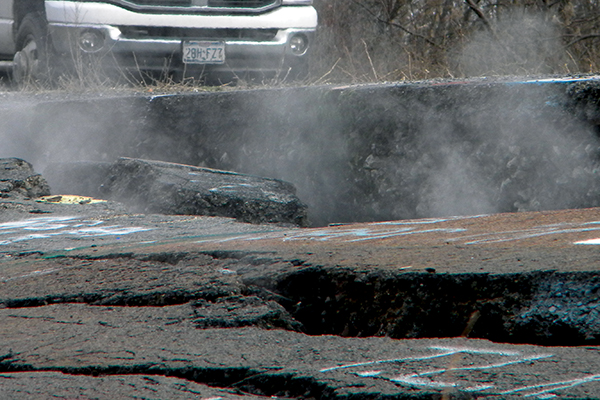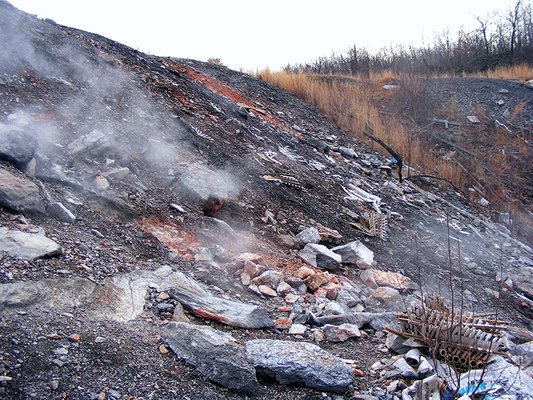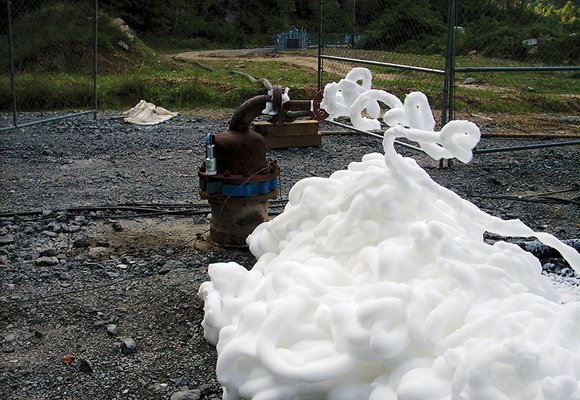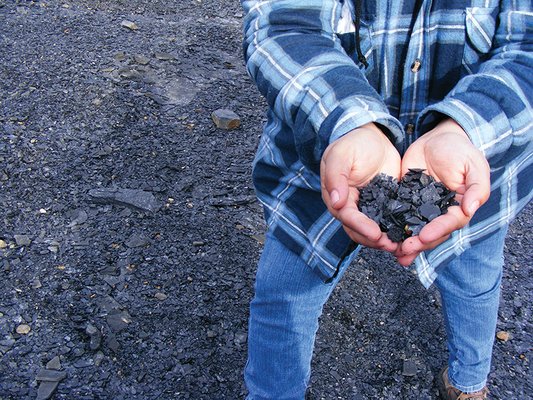
by Mary Caperton Morton Thursday, January 5, 2012

The fire beneath Centralia, Pa., started burning in 1962. Lisa LaFosse

No one knows the full extent of the coal fire burning beneath Centralia. Lisa LaFosse

CAFSCO's foam fills the empty space in a burning mine, snuffing out the fire. Lisa LaFosse

Centralia still holds a lot of coal that could be mined if the fires were put out. Lisa LaFosse
By some accounts, Hell on Earth is located directly below Centralia, Pa.: Smoke rises from the cracked ground, smoldering sinkholes open without warning, and what is left of the town’s abandoned houses and surrounding woodlands is scorched and covered in a layer of smelly sulfur. Once a productive mining town in eastern Pennsylvania’s valuable anthracite coal region, Centralia has been reduced to a smoky ghost town, lacking even a zip code, by an underground coal fire that has been burning for nearly 50 years.
In May 1962, a fire set in an unregulated dump spread to an exposed coal seam and soon invaded the maze of mine tunnels and coal seams underlying Centralia, once a close-knit coal-mining town of 2,600 residents, about an hour northeast of Harrisburg. Early attempts to put out the fires failed. In the 1980s, after a number of residents were sickened by carbon monoxide fumes and a 12-year-old child was nearly killed by a sudden ground collapse, the town was deemed uninhabitable and most of the residents were bought out and relocated.
More than 20 years after the last attempts to put out the flames, the Centralia inferno still shows no signs of burning out on its own, now burning along multiple coal seams in four different directions. Firefighting technology has come a long way in the past two decades, however, and now an innovative Texas-based company wants to take a crack at putting out Centralia’s fires, hoping to prove once and for all that valuable mines don’t need to be left to burn.
Coal fires are a problem all over the world. Such fires endanger nearby communities, waste precious resources and produce tons of noxious and greenhouse gases. Centralia is not the only coal fire burning in the United States. In fact, it’s just one of 38 burning in Pennsylvania alone. The hundreds of underground fires in the United States, from Pennsylvania to Alabama to Wyoming, combined with the thousands thought to be burning in China, India and elsewhere, are one of the largest sources of carbon dioxide and pollution on Earth.
China alone loses between 100 million and 200 million tons of coal each year to mine fires, as much as 20 percent of their annual production, according to the International Institute for Geo-Information Science and Earth Observation, based in Enschede, Netherlands. The Institute estimates that carbon dioxide emissions from these fires are as high as 1.1 billion metric tons, more than the total carbon dioxide emissions from automobiles in the United States. Second to China is India, where 10 million tons of coal burns annually in mine fires, contributing a further 51 million metric tons of carbon dioxide to the atmosphere.
In addition to carbon dioxide, “coal fires produce as many as 60 different toxic compounds, many of which are carcinogenic,” says Glenn Stracher, an expert on coal fires at East Georgia College in Swainsboro. Such toxins include arsenic, selenium, fluorine, sulfur, lead, copper, bismuth, tin, germanium and mercury, he says. Robert Finkelman, a medical geologist at the University of Texas at Dallas, estimates that 40 tons of mercury are released every year by uncontrolled coal fires, which is on a par with the amount produced by coal-fired power plants in the United States. “If we could extinguish those fires,” he says, “it would make a worthwhile contribution to reducing mercury pollution as well as carbon dioxide and other toxic elements.”
Despite their impact, many coal fires are left to burn because mine fires are too dangerous, costly and difficult to deal with. Part of the problem is that effective firefighting options are limited. Using water can cause steam explosions. Cement and fly ash slurries from the surface can sometimes be used to seal mine openings and cut off the fire’s oxygen and fuel supply, but this technique usually only works on smaller fires — not big blazes like Centralia, which has a cavernous network of oxygen-supplying tunnels. Another technique is to dig out the fire and smother it on the surface, but again, this technique is too dangerous and too costly to use on a fire as large as Centralia. Because of these firefighting problems, fires like Centralia aren’t extinguished unless they directly impact nearby communities or are near a gas line or are otherwise imminently dangerous, Stracher says.
The issue of how to deal with Centralia is particularly difficult for a state like Pennsylvania. “Pennsylvania has the largest abandoned mine problem in the country and we’re working with a limited budget,” says Tom Rathbun, a spokesperson for Pennsylvania’s Department of Environmental Protection (PDEP), based in Harrisburg. PDEP works closely with the federal Office of Surface Mining (OSM) to determine which of Pennsylvania’s many mine reclamation projects are the most pressing, and all funding must be approved by the federal agency.
After Congress passed the Surface Mining Control and Reclamation Act in 1977, OSM inventoried abandoned mines around the country and prioritized them according to danger to the public. Open pits, open mine shafts and exposed coal seams where fires might start were given priority-funding status, Priority 1. Putting out already-existing fires that were not deemed a direct danger to the public was not.
“Our first role is to prevent new fires from happening,” says Bill Ehler, a project manager with OSM. The best recourse for dealing with coal fires is to keep them from lighting in the first place, or to put them out early, before they get Centralia-sized, he says. “Centralia is a unique case. We tried to abate it not long after it ignited and found it was already too far out of control. Our only option was to move the community, which took an act of Congress,” he says. “Buying out a town is generally not our usual process.”
After it was abandoned in the late 1980s, Centralia was classified as a Priority 2 site, where it has remained, as the fires are not “presenting a danger to the public at this time,” Rathbun says. “The problem is that Pennsylvania has about $1.4 billion in Priority 1 sites,” he says. “We need to take care of those before we worry about Centralia. The Office of Surface Mines simply will not approve spending most of our budget on one project with low priority.”
But as practical as that assessment might be, Stracher, who has studied Centralia for 25 years, begs to differ. “They aren’t taking into account the environmental consequences of Centralia, which are catastrophic,” he says. “Even from an energy point of view, it’s a catastrophe. That’s a lot of high-grade coal under there that’s completely going to waste.” And it’s releasing dangerous toxins into the air as well as polluting the groundwater, he says. Those are some good reasons to try to put out the flames.
“We get an awful lot of calls from people who have lots of ideas about how to put out Centralia,” Rathbun says. “Centralia is a different animal though, a very large and complex system. Somebody would have to do some serious geologic work and make a plan that would have an almost guaranteed chance of working before we would seriously consider it.”
Nobody knows how large the area burning under Centralia is today. The last detailed study of the fire was in 1983: PDEP and OSM hired GAI Consultants, an engineering and environmental consulting firm based in Pittsburgh, to map the fire and develop mitigation plans. At that time, GAI found that the fire was spread over almost 80 hectares, and estimated it could eventually burn close to 1,500 hectares. But now, says Stanley Michalski, a geologist on that team, “we really have no idea how big it is or where exactly it’s burning.”
At the end of the study, GAI estimated it would cost upward of $600 million to completely dig out the fire, which was the only viable firefighting technique at the time. “Everybody choked on that number,” Michalski says. And so the federal government bought out the town for $42 million (although a few residents refused to leave), and for the next 20 years, the fire has continued to burn.
Then, two years ago, Michalski drew up a new, detailed plan to cut off one of Centralia’s four main fires. “Centralia’s fire is shaped like the letter H, with four limbs moving off in four different directions,” he says. Michalski, who has drawn up successful coal firefighting plans for several other Pennsylvania fires, proposed cutting off the fire’s northwest limb by filling strategic slices of the mine with coal combustion ash that wouldn’t fuel the advancing fire. “If this method worked on this one limb, we could then build three more barriers and effectively contain the fire in a box where it could eventually burn itself out,” he says.
Michalski took his idea to PDEP and was met with a lot of positive feedback, he says. But, to his knowledge, no further action was taken by the agency.
Now, a commercial firefighting company, CAFSCO Fire Control, based in Fort Worth, Texas, has its sights set on Centralia. The company’s compressed nitrogen foam system — originally invented to combat forest fires — has been adapted to fight underground coal fires with much success.
“There are no limits to the types of mines or size of fire that we can put out,” says Lisa LaFosse, co-owner of CAFSCO. “We can fill up any mine with foam,” she says. Furthermore, adds Mark Cummins, founder and co-owner of CAFSCO, the company’s system is safer and more cost-effective than the tried-and-true technique of digging out the fires. “We can put out a fire at a tenth of the usual cost, and we don’t even have to see the fire to fight it,” he says. CAFSCO’s method would also allow for future mining of an area’s unburned coal seams, unlike digging out the fire.
CAFSCO’s biodegradable fire-suppressing foam works in a number of ways to put out underground coal fires. Pumped into an underground mine through surface boreholes, the foam quickly expands to fill all the available space, saturating the interior of the mine from floor to ceiling, effectively soaking all the fuel and smothering the fire. The expansion of the foam also creates positive pressure in the underground spaces of the mine, forcing out any unconsumed oxygen that could further feed the fire. CAFSCO’s foam differs from other types of firefighting foam in that it contains no oxygen, only nitrogen, which works chemically to smother the fire.
The system has worked in dozens of coal fires across the United States, according to CAFSCO. In 2007, CAFSCO put out its largest coal fire yet, pumping more than 700 million gallons of foam into the Consolidated Buchanan No. 1 coal mine in Claypool Hill, Va. Cummins says Centralia could be put out in about a month, for about $60 million. “I understand the difficulties of the Centralia fire, but I know what this foam is capable of doing and I really believe we can put it out,” he says.
Stracher, for one, thinks CAFSCO can get the Centralia job done. “I’ve seen this foam in action and it’s really unbelievable what it can do,” he says. Rathbun, however, remains wary of the new foam technique because he has not yet seen it in use. Before PDEP would consider approving such a project, “we would need to see more evidence, track records, proof that it works,” he says. “Centralia is a huge project and we don’t have the money to experiment with it.”
CAFSCO staff are currently working with PDEP on some smaller fires in Pennsylvania’s anthracite region, hoping to establish a relationship with the agency and work their way up to Centralia. “I’m about ready to retire and I’d love to go out on the Centralia fire,” Cummins says. “Hopefully we can convince them it’s high time to put this thing out.”
Budget issues aside, Stracher sees extinguishing Centralia as an opportunity to change how coal fires are dealt with, not just in the United States, but also around the world. “If we can put out Centralia, one of the most problematic and longest-burning fires in the U.S., it could be a turning point,” he says. “Now that we have the technology to deal with this staggering source of pollution, it’s high time we start putting it to use.”
© 2008-2021. All rights reserved. Any copying, redistribution or retransmission of any of the contents of this service without the expressed written permission of the American Geosciences Institute is expressly prohibited. Click here for all copyright requests.